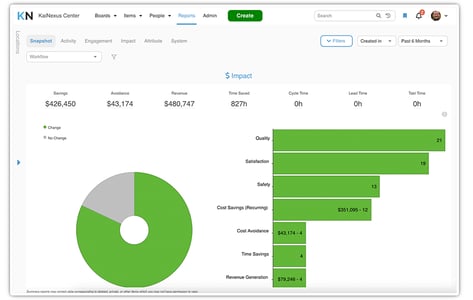 The renowned football coach and philosopher Vince Lombardi once said, “Perfection is unattainable, but if we chase perfection, we catch excellence.”
The renowned football coach and philosopher Vince Lombardi once said, “Perfection is unattainable, but if we chase perfection, we catch excellence.”
That’s the mindset of a Lean organization. There’s a bedrock belief that every process, investment, employee, or action should directly translate to value for the customer with no waste. That ideal is unattainable, of course, but Lean organizations try to get close to it every day and, in doing so, reach a level of success that their competitors can only envy. Every Lean organization is unique, but there are some core qualities that they tend to have in common.
1. Focused
Lean organizations are obsessed with customer value. They recognize that by establishing customer value as the number one priority for every employee, manager, and executive, other business metrics will fall in line. That's why every decision involves an assessment of how it will impact the customer. Other organizations might focus obsessively on safety and quality, likewise realizing other metrics will follow.
2. Aligned
In a Lean organization, every member of the team understands the mission, values, and strategic priorities of the business. This is achieved through open lines of communication between front-line staff and senior leaders, and the development of a culture in which individuals are empowered to help the organization achieve those goals. This results in an army of people focused on improving the organization.
3. Humble
One of the central tenets of Kaizen, the philosophy at the heart of Lean, is that there is always room for improvement. Even when the organization is doing well, leaders encourage people to find ways to drive further success. After all, continuous improvement is not something you can ever finish. A Lean organization recognizes that there are endless opportunities to improve.
4. Collaborative
Silos have no place in the practice of Lean. Cross-functional collaboration and communication are necessary to tackle the biggest challenges. Organizations that provide people with the tools they need to break down silos and share knowledge and experiences across the organization to drive company-wide improvement.
5. Tenacious
Lean organizations do not opt for workarounds or simple answers to complex questions. They seek out and address root causes by empowering the people doing the work to speak up, identify problems, and improve them. Lean organizations are not interested in applying Band-Aids and short-term fixes.
6. Engaged
Lean is a business process methodology that leverages the skills, input, and observations of every employee. Employees who are invested in the success of the organization and engaged in improvement are essential. There is a ton that leaders can to do increase their employee engagement in improvement, and we write about it a lot on this blog. Be sure to subscribe at the bottom of this post to ensure you don't miss anything.
7. Methodical
Improvement work is most effective when intentional practices such as PDSA, A3, Catchball, and Hoshin Kanri are applied. Whatever methodology your organization has chosen to propel continuous improvement, it's important to remember that it must be simple, habitual, and consistent across the organization. The methodology behind your improvement work is what drives long-term success in a Lean organization.
8. Proactive
Lean organizations inspect processes, not products, to prevent problems and waste before they happen. How do they do that? By engaging employees in the work. Managers don't oversee every process, so while they might notice failures in the end product (or service), it's up to the people doing the work to notice ways to improve the process. Lean organizations have successfully created a culture in which employees feel safe speaking up and taking the time to make improvements along the way.
9. Documented
Standard work is documented, accessible, and continually reviewed in Lean organizations. This creates uniform processes across the organization and allows everyone to start at the same elevated level as they improve, rather than constantly reinventing the wheel. I think it's important to point out here, though, that just because a process is documented doesn't mean that the improvement process is over. It just means that the current best practice has been identified and shared; in a Lean organization, people are expected to use this as the starting point for future improvement.
10. Resilient
Resilience in Lean organizations is the ability to anticipate trouble spots and improvise when the unexpected occurs. The organization must be able to identify errors for correction while at the same time innovating solutions. This is done by empowering employees to make autonomous decisions whenever possible so that they can respond with speed and agility.
11. Progressive
Most organizations that successfully apply the Lean way realize that the improvement process requires the support of enabling technology. After all, there are a lot of people working together on improvement and a limited amount of time on which to work on improvement. To ensure that they get the most done in the least amount of time, they reduce their administrative and communicative burdens by relying on continuous improvement software solutions that help move the improvement process forward with alerts, notifications, and improvement impact reporting.

12. Grateful
In order for Lean culture to take hold, employees must feel valued and recognized for their contributions to improvement. Smart leaders realize this and broadcast employee successes at every opportunity.
![[Watch Now] How to Leverage Lean for Long-Term Success](https://no-cache.hubspot.com/cta/default/326641/eb5ac7b8-b040-48b7-810e-1589561ffff9.png)
![[Watch Now] Components of an Employee-Led Lean Initiative](https://no-cache.hubspot.com/cta/default/326641/a91195a9-a959-420e-b46f-d1a97a8175ba.png)


Add a Comment